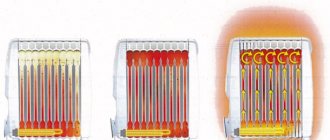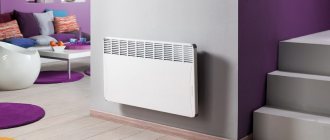Providing additional heat in a residential or commercial space is the most important factor in comfort when cold weather sets in.
To understand whether a convector or an infrared heater is better, we decided to analyze the main features of devices of these types.
For the analysis, the following criteria were taken: operating principle, level of environmental friendliness and safety, price factor, dimensions, comfort of use, speed of heating the room, mobility and others.
How does it work
Note!
The operating principle of the described device is based on the phenomenon of convection. From the physics course we know that cold air is heavier than warm air, it is located in the lower part of the room, the heated air masses gradually rise upward. Due to such movements, the entire air space in the room is heated.
The convector operates according to a simple algorithm. At the bottom of this device there is a heating element (it is also called a heat exchanger). To increase the volume of air passed through, this part is made in the form of a radiator with several flat fins. The angle of their inclination regulates the direction of heated air flows. The heat exchanger is covered by a protective metal casing.
According to the energy carrier used, all convectors can be divided into the following types:
- Devices powered by electricity;
- Gas convectors;
- Mermen.
Design of a convector heater
At the top, as well as at the bottom of the convector body, there are several holes for sucking in cold air and transporting heated air. Structurally, it is made in such a way that the body of our device does not have direct contact with the heat sink, so the casing does not heat up and does not transfer heat. A similar transfer of heat resources occurs in water and oil radiators.
In everyday life, electric type convectors are mainly used. Water appliances have lower efficiency indicators; they differ from analogues in their significant overall dimensions, so they are installed in places where traditional water radiators are installed in niches under windows. Gas equipment, despite the possibility of saving energy resources, for some reason is not popular among consumers.
Comfort and coziness
Infrared heaters have one feature - they heat everything that is exposed to infrared radiation. This can be both a plus and a minus. This is especially true for ceiling models.
Of course, if you come from the cold to a warm room, it will be nice to warm up under the heater. Infrared radiation will quickly warm up your clothes and your body. But it is not always comfortable to be under it all the time.
The radiation from a ceiling heater is more powerful the shorter the distance to it. With a high power of the device, it will literally bake your head, which is not particularly comfortable.
The second disadvantage of infrared heaters is periodic switching on and off. This is especially true when the radiation hits you directly. You will constantly feel your body heating up and cooling down.
Convectors have only one big disadvantage - they cannot effectively heat the lower part of the room. That is, you will constantly have to walk on a cold floor. Ceiling infrared heaters do not have this drawback. They primarily heat the floor.
How to choose for a dacha
When choosing the heating device in question for use in the country, you should pay attention to the following parameters:
- Safety of use of the device;
- Durability indicators;
- Price;
- Economical use of electricity or other coolants.
Convector heater in the interior of a room
When choosing between a wall-mounted and floor-mounted model, you need to take into account the fact of using the device. Many types of electric convectors are fixed to the wall surface, but if there is a need to move the heating device, it will be necessary to purchase additional equipment (wheels, protection against heating during accidental tipping).
The height of floor convectors does not exceed 20 centimeters, they are narrow and long. Wall-mounted models reach 50 centimeters in height. According to experts, devices that are located as close to the floor surface as possible have maximum efficiency, because heated air moves from top to bottom. In this regard, it is better not to buy wall-mounted equipment, or install such devices as close to the floor surface as possible.
When purchasing such devices, you need to pay special attention to the material and workmanship of the case, its overall dimensions, and design. Here you need to take into account the height of the body: the larger it is, the greater will be the air flow speed or the convector properties of the heater
Skirting convectors up to 20 centimeters in height heat the air well due to their significant dimensions; their length can reach up to 2.5 meters. A tall (up to 60 centimeters) heating device, in which the speed of air flow increases, will be more compact.
It is better to install the convector closer to the floor
Reviews about what is better to heat a house - a convector or an infrared heater
Ilya Vladimirovich Dashkov, 35 years old, Moscow
When choosing a heater for the apartment, we ended up buying a regular convector model. Judging by the descriptions, IR radiators work faster, but we realized that we would not be able to position the device so that exactly the right places were heated. So far everyone is happy with the convector; within a few minutes after turning it on, the room becomes warmer.
Lanina Anastasia Viktorovna, 40 years old, Kaluga
I used a convector heater for a long time, but this year I bought an infrared one to replace it. I installed it on the wall in the living room, I am very pleased with the results - I almost instantly feel the effect of the device. I like that the device does not dry out the air; the level of humidity in the apartment in winter is already a big problem.
Convectors operating principle and features
The operating principle of KO is based on convection - air circulation. The air flow passes through the heating plates and raises the heat upward. The coolant, in our case air, most often circulates through a small pipe with a connected heating element. Infrared-convective heaters are powered in two ways:
electricity
Such devices have a closed loop of pipes through which air flows. The design of the device is made in such a way that air penetrates into all the cracks of the radiator as quickly as possible. Often a fan is installed in electrical appliances to speed up the heating of the room. Electric convectors replace conventional heating radiators and are easily installed on the wall. The latest generation models can be installed under the floor.
natural gas
Convector-type gas heaters use air from the street to burn gas, and they also send combustion products there.
Convectors powered by gas are considered a good option, since they do not depend on central supply networks, can be installed in any room and are much cheaper than their analogues. As always, there is one “but” - gas equipment requires the output of a coaxial pipe, which removes combustion products. To do this you will have to disturb the wall of the house. In addition, any “gas” work requires drawing up a project plan and its approval by the relevant services
. According to the law, the owner of the home, even if he wants, cannot install the equipment himself; for this, there are special authorities with a license for this type of activity. If the price of blue fuel in your region is low, then of all the options you should choose a gas convector.
Scope of use
The main feature of convectors is the ability to heat the entire room, and not just a specific area, such as a convector or an infrared-convective heater. The flow of hot air extends to the entire room, but the efficiency is still limited - the convector is afraid of drafts. If you have a large room, poor thermal insulation and frequent drafts, then this is not the best choice. Therefore, the optimal room is a small room with sufficient insulation, for example, insulated walls and high-quality windows.
Features of convectors
Convective heaters raise the temperature in the room. This is both an advantage of the devices and a weak point. When you want warmth in a nook, convective heaters are the perfect solution. The warm current will quickly spread throughout the room. If we are talking about a workshop with drafts, convective heating is not the best solution. The room will begin to cool down, and the long-awaited warmth will not come. In the latter case, infrared heaters will be much better.
You don’t always want to see heavy radiators on the walls. It is simply impossible to hang it on the ceiling; batteries are not designed to operate. When a warm stream of a convector blows out from under the floor, it’s not bad, but if you try to mount the thing in the ceiling, the circulation of air masses is disrupted. Warm air rises, we observe the probability that it will remain warm there. Installation under the floor is not always convenient - it is necessary to leave large gaps for the circulating flow.
The advantages of convector heaters are manifested in a small room, well isolated from the external environment - for example, the windows are insulated. Then the devices give tangible results. Within 4-5 minutes you will feel the effect of heat spreading throughout the room. The temperature of the radiators is relatively low, the devices do not burn air, and do not cause harm to humans when touched, making them a smart choice for children’s rooms or bedrooms.
The type of device under consideration has limitations, but it is simply incorrect to talk about the disadvantages of convector heaters.
Date: September 25, 2022
Floor-standing
The Ballu BEP/EXT -1500 convector is designed for heating rooms with an area of 20 m2. This device operates on a 220-volt power supply and has several power switching modes, which allows you to achieve the optimal temperature for heating the room. The model is equipped with special wheels for easy movement around the room, there is protection against overheating and accidental tipping, there is a control panel and a timer. The price of the model is 4220 rubles.
The advantages of the model are: beautiful appearance, a 3-year warranty on the product, low power consumption. Cons: clicking noises are heard when the thermostat operates, an unpleasant smell when first heating up, the display is bright.
Ballu BEPEXT -1500 differs from the previous model in size and power
The Electrolux ECH/AG-1000MFR convector with a power of 1 kW is designed for heating small, including wet rooms with an area of 15 m2. The controls in this device are mechanical, it is possible to control the temperature, there is a dust filter, as well as protection against overheating. The heater has a moisture-proof housing, the price of the model is 2,450 rubles.
The advantages of Electrolux ECH/AG-1000MFR include: excellent functionality, fast heating of the room, small overall dimensions, absence of foreign odors during operation of the device. No deficiencies found.
Convector Electrolux ECH/AG-1000MFR
Thermor Evidence 2 Elec 1500 with a power of 1.5 kW is designed for heating rooms with an area of 15 m2. This model has electronic control, it is possible to adjust the temperature automatically. The device has a waterproof housing and protection against overheating and frost. The price of Thermor Evidence 2 Elec 1500 is 4,400 rubles.
The main advantages of this convector are: beautiful appearance, ease of use, quick heating of rooms, and can withstand significant voltage drops. The disadvantages include the high cost of additional equipment.
Thermor Evidence 2 Elec 1500
The Hyundai H-HV14-20-UI540 heater with two heating elements of 1.25 and 0.75 kW can operate in three modes. At maximum power, it is possible to heat rooms with an area of 24 m2. The device connects to a 220-volt household power supply, is equipped with a digital display, and has mechanical control. The device has built-in overheating protection, its price is 1,590 rubles.
Hyundai H-HV14-20-UI540
The advantages of the Hyundai H-HV14-20-UI540 include affordable cost, the ability to save energy by turning off the temperature relay when the room is intensively heated, fast heating, small dimensions and weight. Disadvantages: foreign odors when the device is first started, high body temperature, thermostat clicks.
https://youtube.com/watch?v=ToD4P-MjqxU%3F
Convectors: pros and cons
| Advantages | Disadvantages |
| Warms up comprehensively. Even after switching off, the temperature remains for quite a long time and drops slowly | In dusty rooms, convection causes dust to rise from the floor. This problem can be solved by air washing - it “nails” it |
| All dangerous parts are hidden deep, and some models have additional protection against overheating (like Neoclima Dolce 2) | Not suitable for heating large, semi-open and open spaces. The visible result will be in closed rooms with an area of up to 20-30 meters |
| Silent operation | Warms up slowly. For the first 10-20 minutes the heat will be concentrated near the ceiling, then the room will be filled with warmth |
| There are many options for “hidden” installation - such convectors are built into the floor and are invisible to others | — |
| Warms only the air, not the furniture, the possibility of fires is minimized | — |
Please note: Tips on how to choose a heater: top 5 popular types and rating of the best models
Energy costs
To find out which is more economical - an infrared or convector device, you need to create the same conditions inside and outside the house. With hermetically sealed thermal insulation, the presence of interior doors and the same starting temperature indoors and outdoors, the IR emitter will consume less, since it only needs to spot heat the zones and then maintain the heat. In addition, it initially requires less power to reach a certain temperature. The convector must operate continuously. This explains the higher average price for IR heaters.
This comparison is correct only for insulated houses. In the case when you need to heat an open room or heating is carried out in severe frosts, an infrared fireplace will absorb approximately the same amount of energy as a convection fireplace.
How to choose a heater: we help you decide on the criteria
A household heater for an apartment or country house, as a rule, is a fairly simple device. Of course, sometimes you can find high-tech heaters with remote control from a smartphone, but in most cases there is nothing complicated in such devices.
Accordingly, choosing a suitable heater will not be too difficult. The main thing is to decide on the basic parameters. First of all, this is the type of heater and its power, and secondly, additional features and options.
Heater type
There are several differently designed heaters on the modern market, which differ not only in type, but also in their qualities - some of them are better suited for a city apartment, others for a country house, and others for heating technical premises. Let's figure out what types of heaters there are and how they differ.
On store shelves you can find oil radiators, fan heaters, heat guns, convectors, infrared heaters, infrared film, infrared convective heaters and thermal curtains. Let's look at them, starting with the simplest models.
Oil radiators
An oil radiator is familiar to everyone: this is the type of heater that can most often be found in a country house (especially if it was built more than twenty years ago). The oil radiator is a sealed metal housing, inside of which a special mineral oil is filled. The heating element (electric coil) is also located inside the housing. Thus, the spiral heats the oil, the oil heats the body, and the heater body heats the surrounding air.
Oil radiator Sencor soh-2107bk is a typical representative of its class
Visually, an oil radiator is similar to a central heating battery: it often has similar compartments. As a rule, such a heater does not have a fan.
Like a central heating radiator, an oil radiator is best suited for use in areas where constant air heating is required. It takes a long time to warm up and does not immediately begin heating the air. On the other hand, the temperature of the radiator itself is not so high as to burn dust particles that fall on it (and therefore, there will be no foreign smell in the room). Oil heaters operate almost silently, retain heat for a long time after being turned off and are considered environmentally friendly. Among the minuses, it is worth noting their rather large size and low mobility (even despite the presence of special wheeled legs).
It’s easy to imagine that if you take two heaters of equal power, the more compact one will have a higher temperature. Therefore, it is better to choose a larger model (if space allows), which will reduce the likelihood of accidental burns.
Fan heaters
A fan heater is a combination of a heating element (we'll talk about their types later) and a fan that circulates air in the room. Many of these devices can work as a regular fan, but they cannot heat the air with the fan turned off - accordingly, there are no silent fan heaters. However, we would not seriously recommend using such a device in the “without heating” mode as a regular fan: they usually blow rather weakly, and in order to create the effect of a “cooling breeze”, you will have to place it directly opposite you at a distance of no more than a meter.
Fan heater Ballu BFH/S-04 - small and compact
The main task of a fan heater is to quickly heat the air in a cold room. Indeed, the effect of such a heater becomes noticeable in just a few minutes. Well, if you need to heat a construction site or a large room, then a heat gun is suitable for solving this problem - essentially the same heat fan, characterized by increased power and the ability to operate for a long time without pauses. The “payback” for fast and powerful heating will be a high noise level and corresponding electricity consumption: many owners of country houses, especially those built quite a long time ago, are faced with the fact that it is not possible to heat more than two rooms with fan heaters, since they are simply “eat up” all the power supplied to the house.
Also, do not forget that heat guns come in very high power - for example, 5 kW, and even more. Not every outlet and not every wiring can withstand such energy consumption.
Heat guns of the Prorab series clearly hint at use during repairs
Many expensive fan heaters have a built-in motor, which ensures rotation of the device in a horizontal plane and, as a result, improved air circulation and more uniform heating of the room.
Also worth mentioning are the so-called “ceramic” fan heaters - their metal spiral is not blown directly with air, but serves to heat the ceramic heating element, which, in turn, heats the air. Ceramic fan heaters are practically free of the main drawback of a conventional fan heater - the characteristic smell of “burnt dust”, which arises from the combustion of dust particles falling directly on the hot wire.
Convectors
A convection heater works in a similar way. The difference from a fan heater here is the absence of a fan itself: the air in a convector heater passes through the heating element, after which it naturally rises, making room for colder layers of air that rise from the floor. As a result, the size of the heating element of such a heater will be significantly larger (in terms of dimensions it can be compared with a “flat” central heating battery).
Convector heater Optima CH-1600Y/W with temperature control and wall mounting option
Convector heaters are suitable for wall mounting and usually look quite stylish. True, they do not heat the air as quickly as heat fans.
Note that convectors are ideal for combining into a single network, which allows centralized control of the heating of one or several rooms.
Infrared heaters
Infrared heaters are designed in a fundamentally different way: they heat not the air, but the surrounding objects (primarily the floor or walls) using infrared radiation. The air in the room is already heated by them. The heating element of such heaters are quartz tubes or lamps.
Glass infrared heater Peony Thermo Glass from a domestic manufacturer
Infrared heaters operate silently and can be used where heating of surrounding objects rather than air is required - for example, outdoors (for heating gazebos and verandas). They are also often used in bathrooms. They are also ideal for working in rooms where it is necessary to maintain a certain low temperature, and it seems impractical to heat the entire volume of air. But for heating rooms where there are many rooms and/or partitions, they are not very suitable: infrared rays will not be able to go around multiple obstacles.
It should be mentioned that since IR radiation heats the objects it hits, one of these objects is a person in the room. Therefore, the “feeling of warmth” from the IR heater appears almost immediately after it is turned on. However, there are a few things to consider here:
- the sensation has appeared - but the ambient temperature has not yet changed;
- heat only to those parts of the body that are exposed to radiation;
- Depending on the distance to the IR heater, you can either feel the heat or not feel anything at all.
It is worth highlighting such types of infrared heaters as “infrared-convective” and “infrared film”. The first of them combine the advantages of convective and infrared models. Heating is provided both by a heating element located inside the heater and by heat transfer from the front surface of the heater. According to the developers, this “combined” heating method allows you to create a comfortable microclimate in the room without unnecessary energy costs.
UFO wall-mounted film heater disguised as a painting
As for infrared film heaters, they are a thin heating element made of film and foil. Such heaters are often made in the form of rugs or wall paintings (the design of such paintings, however, is questionable). They were also used as “warm floors”. The power of infrared film heaters usually does not exceed 400-500 W.
Thermal curtains
Thermal curtains are a separate category of devices that also act as a heater. Thermal curtains are installed in door (or window) openings and create a flow of warm air that blocks drafts. Thermal curtains are usually used in rooms where doors are often opened (for example, in offices), or where there is a danger of drafts and an additional warm zone needs to be created.
Electric thermal curtain Daire HT 508 with power up to 5 kW
They can also cope with heating small rooms, but a thermal curtain cannot cope with complex heating tasks. It is worth noting that the power of the thermal curtain must be selected in accordance with the size of the door or window on which it will be installed.
Efficiency and performance
For each heater, the manufacturer indicates the comfortable and maximum area of the room for which a particular device is intended. Thanks to these parameters, it is easiest to understand what power device you will need. In most cases, the dependence here will turn out to be strictly linear: if the heater’s power is twice as high, then it will produce approximately twice as much heat per unit time.
The type of heater in this case does not matter: if two heaters spent the same amount of energy, then they heated the room equally (but not necessarily in the same time!).
Control and display
Simple heaters have a mechanical control system, which looks like a set of temperature-regulating knobs and on/off buttons. Such heaters can operate in full or partial load mode and switch off on their own when a certain temperature is reached, but, as a rule, they are not capable of more.
It should also be taken into account that the temperature control will be quite rough, and, as a rule, not in degrees, but in the form of a rotating knob with the values “minimum”, “maximum” and several intermediate nameless gradations. Thus, you will be faced with a rather long procedure for selecting the optimal position of this knob in accordance with your own feelings about the temperature in the room.
Mechanical heater control system
Modern models are increasingly equipped with an electronic control system, including a set of mechanical or touch buttons and a digital display. The capabilities of such heaters are much wider: they can turn on and off according to a schedule, maintain a set temperature (in degrees) in the room, display the temperature and current time on the display, and much more. Such heaters often come with a remote control.
Electronic control system with temperature indication
Finally, the most “advanced” heaters have the ability to be remotely controlled. Such devices have a built-in Wi-Fi or Bluetooth transmitter, so you can control the device from your smartphone using a special application.
Features and functions
Depending on the complexity, the heater may have a different set of capabilities and functions. The simplest heaters (for example, many oil heaters) heat up to a certain temperature, after which they turn off for a while. More advanced devices are able to control the temperature in the room and turn on and off depending on environmental conditions.
Heaters with an electronic control system can be equipped with a delayed start and end time, turn on and off according to a schedule, and often have a set of programs for various use scenarios.
Heaters with remote control via Bluetooth or Wi-Fi allow the user to control their operation remotely. Thanks to this solution, the heater can be turned on or off remotely. For example, it will be useful to turn on the heater before going to the countryside so that you arrive at a house that has already been warmed up.
Noise level
For most heaters, the documentation indicates the maximum noise level. You need to look at this parameter if the heater is installed in the bedroom, in the nursery or in the study - in general, where silence is required. The quietest heaters are infrared. They are followed by oil heaters, convector type heaters, and then fan heaters and heat guns.
It is worth considering that sometimes noise can be made by a temperature relay or a speaker that notifies the user of a change in operating mode (or is triggered when buttons are pressed). Since such sounds can be quite annoying, it is better to make sure in advance that there are no such effects. By the way, it doesn’t hurt to check the brightness of the display so that it doesn’t suddenly turn out that the heater that is supposed to be installed in the bedroom is shining too brightly.
Protection
Almost all heaters have a safety system that turns them off if they overheat. A built-in fuse or overheat sensor located at the air outlet will avoid fire and unnecessary load on the electrical network.
Many heaters also have a system that turns off the unit if it is dropped. Provided that safety precautions are observed (the heater is installed correctly and is not covered with rags or foreign objects), such systems guarantee that the device will not cause a fire.
However, you can still get burned on many heaters. Therefore, if there are children and elderly people in the house, it is better to think about buying the safest possible heater that will be difficult to snag or drop (such as wall heaters).
If the heater is intended to be installed in the bathroom, you should pay attention to models with a waterproof housing. This will allow you not to worry about water getting into the device body and a possible short circuit. Using a heater in the bathroom will not only achieve a comfortable temperature, but also prevent the appearance of fungus on the walls.
Installation type
Different heaters allow different installation methods. Many of them are simply placed on the floor (oil heaters) and have special wheels for moving. Others allow installation on any flat surface, such as a table or window sill (many fan heaters include these). Such heaters do not require special installation efforts. At the most, the user will have to assemble the legs with wheels themselves.
Also, many heaters have several installation options for the user to choose from: wall, floor, ceiling or suspended ceiling. Moreover, the same model can allow several installation options at once (for example, wall or ceiling). In this case, the installation will require a drill or hammer drill and other related tools with which to install the fasteners.
Let's sum it up
Household electric heaters come in four main types:
- oil radiator
- fan heater or heat gun
- convector
- infrared heater
The main distinctive properties of the heater, critical for the user, are:
- room heating rate
- noisiness
- mobility, i.e. ease of moving the heater from place to place
- negative impact on the air
A table in which we have evaluated each parameter for each type of heater will help you make your final choice.
| Room heating speed | Noisiness | Mobility | Air exposure | |
| Oil radiator | low | low | average | No |
| Fan heater | high | high | high | smell of "burnt dust" |
| Heat gun | very high | very high | high | smell of "burnt dust" |
| Ceramic fan heater | average | high | high | almost odorless |
| Convector | low | silent | average | No |
| Infrared heater | low | silent | low | No |
Comparison of features
The speed of air heating with convectors is very low, but they allow you to achieve the most uniform temperature distribution. You won’t be able to warm up in a cold room with a convection heater; you’ll have to wait several hours. The heat from the infrared emitter can be felt almost immediately, and there will be no accumulation of warm air near the ceiling. You can direct the beams directly to the area where a person is located.
Uniform heating of air using a convector is only possible in a closed room. In case of drafts, the device will not be able to warm up the room, because cold air will constantly fall in place of warm air. Infrared radiation heats objects, so even with a small draft it provides. There are projects for using infrared heaters even outdoors.
Ease of use depends on the configuration of the device. Wall-mounted convector models do not take up additional space and are easy to use. Free-standing devices may interfere with movement. Portable infrared heaters require a significant area for placement. To free up space, it is recommended to purchase hanging models that can be located on the walls or ceiling.
Unlike infrared heaters, convectors do not require monitoring of their operation. The device can be safely left turned on unattended. Infrared devices are characterized by a greater fire hazard, so it is recommended to use them with constant monitoring.
Do not direct the radiation of infrared devices at surfaces that may be damaged by elevated temperatures. Nearby furniture and interior items can become very hot.
The electrical safety of both types of devices is the same, but the infrared lamp heats up to high temperatures, therefore it is always protected by a special mesh from accidental touch, which can lead to burns. The infrared heater must not be covered or used for drying fabrics. Improper use may result in fire.
Infrared heaters are more environmentally friendly because they do not contribute to significant air movement inside the room. Convectors carry out constant circulation, as a result of which dust can rise into the air. But none of the devices of both types emit harmful substances during operation.
Convectors reduce humidity levels much more strongly, so they are recommended to be used in conjunction with humidifiers.
Both types of devices
are characterized by great durability
. Convectors have a reliable design that can operate without breakdowns for 10-15 years. High-quality infrared lamps can last up to 25 years or more.
Energy consumption depends on operating conditions. Research shows that infrared heaters are more economical than convectors. Savings in the use of infrared radiation are achieved due to the high heating rate. After reaching the desired temperature, the infrared heater can be turned off, but the heated objects will remain warm for a long time. And the convector often has to work continuously.
It is not possible to clearly determine which heating method is better. The choice always depends on specific tasks and operating conditions. A good solution would be to combine devices. You can purchase a combined heater or use two devices with different operating principles.
Which heater is more comfortable to use?
Electric convectors are presented in two model options, based on installation features. Wall-mounted models are attached to the wall at a height of 10–15 cm from the floor. Installation does not take much time. Once the device is mounted on the wall, it does not interfere with movement in the room and is not noticeable.
Floor-standing models are compact, equipped with wheels or stand legs. Due to its light weight and parameters, the device is easy to transport from one room to another. The presence of additional functions increases ease of use.
Infrared heaters are divided into mobile and stationary. Mobile models of infrared heaters can easily be moved within a room or transferred to another room. However, the body of an infrared heater often gets very hot, so you need to be careful when changing the orientation of the device or moving it to another room. Although the protective mesh protects from direct contact with the emitter, it has a fairly high temperature.
As for stationary infrared heaters, they are practically no different, in this regard, from convector heaters. They are installed on walls or ceilings and do not cause any inconvenience to the occupants of the room.
Overview of characteristics of infrared convectors power
If you want to choose, it is important to pay attention to the most important characteristic - power. This parameter is selected from the algorithm of 1 kW of device power for every 10 m2. If you plan to use the described unit as the main heat source, then it is advisable to choose a device with a power reserve to compensate for possible heat losses that escape through doors, windows and walls
If you plan to use the described unit as the main source of heat, then it is advisable to choose a device with a power reserve to compensate for possible heat losses that escape through doors, windows and walls.
There are models on the market with a power of 300 W. They can be used for temporary local heating of garages, basements and other utility rooms. For more efficient operation, it is best to place such devices closer to the person. An imported infrared convector is most often designed to be powered from a 240 V network, therefore, when connected to a standard network, the device will not operate at full power
You need to pay attention to this factor when purchasing. Heaters of this type can be electric or gas, the latter type is optimal for heating large areas, including terraces and verandas
Pros and cons of quartz heaters
These devices heat the air using a nichrome heating element. To increase heat transfer and minimize harmful effects on the environment, quartz sand is used. The reflector is a metal plate that is located behind the heater - when infrared rays are reflected, a directional effect is formed.
Pros:
- High energy efficiency - this heating method allows you to significantly save energy;
- Safety - the lamps do not contain harmful impurities (mercury and liquid metal), so they can be disposed of as regular waste;
- Heaters of this type can be used in industrial facilities when quick drying of various surfaces or things, drying of vegetables, etc. is required;
- Instant heating of the room;
- A special flask for the heater eliminates the burning of oxygen;
- Long service life and high reliability;
Minuses:
- Relatively high mass (for quartz monolithic systems);
- High heating of the surfaces of the device during operation at full power - careless use of the device can lead to burns.
- The cost of these devices is quite high.
Choosing between an infrared heater and a convector
Quite often, modern consumers today do not know what to choose - an infrared heater or a convector. What is better, you can understand by reading the article. It is worth recognizing that both of these devices are popular for suburban real estate. Electric convectors have managed to prove themselves, having appeared on the market since the 90s. last century. They are easy to use and easy to follow.
Infrared heaters appeared only 5 years ago, today they are representatives of the latest generation. If you also cannot decide what to choose - a convector or an infrared heater, then you should pay attention to the fact that the first type of device heats the room due to the constant movement of air flows. They arise due to temperature differences in individual areas of the room.
In this case, one layer of air is heated after another, which ensures a relatively uniform temperature.
The disadvantage of such devices is the creation of a comfortable temperature only in a certain part of the room. Therefore, while looking for an answer to the question: “Infrared heater or convector - which is better?”, you will be able to make the right decision only when you become familiar with all the features of these devices. For example, infrared devices heat a room by emitting heat flows with a clear direction. That is why in a minimally short period of time, literally in 10 minutes, the area to which the rays spread will acquire a comfortable temperature. In this case, the energy costs will be insignificant, which is especially noticeable when compared with convectors.
Electric convectors quite often also benefit from the fact that they can fit into almost any interior. Most often, such units are installed in a wall niche or on special legs to make the device mobile
If you are thinking about the question of which is better - a convector or an infrared convector, then you should pay attention to the fact that the latter unit will work not only due to air flows, but also by heating objects. Among other things, infrared heaters can be installed even in the bathroom
If they are placed on the ceiling surface, the floors and tiles in the room will heat up. Experts advise choosing convectors if you want to install an autonomous heating system in your dacha.
Design and savings
Each manufacturer tries to follow the fashion trends of the modern era. Therefore, the appearance of both convectors and quartz heaters is always varied and changes over time, due to which they fit perfectly into the interior of an ordinary city apartment, cottage or country house. If you wish, you can choose the color of the body or purchase removable glass nozzles of various colors for the front surface of the convector, such as, for example, NOBO convectors.
In the photo: Nobo quartz heater and convector in the interior
Due to their design features, quartz heaters are somewhat thinner and more compact than traditional convectors. From an economic point of view, it is believed that quartz heaters are more economical than conventional convectors. An electric convector, consuming 100 W of electricity, produces 95-98 W of heat. That is, the efficiency of its operation ranges from 95% to 98%. These figures are valid for outdoor temperatures down to -24 °C, while indoor temperatures can be maintained down to 29 °C.
Data on the efficiency of a quartz heater, according to various sources, with a consumption of 300 W can produce heat from 500 W to 900 W. However, it is worth noting here that some experimental data indicate that such indicators are valid at slightly negative outdoor temperatures, while the indoor air temperature does not exceed 20-21°C.
Infrared heater
Infrared heaters have the largest number of varieties. The main classification is as follows:
- gas;
- quartz;
- carbon;
- halogen;
- micathermic.
The most common convectors in everyday life include carbon, halogen and quartz. The main working elements are the irradiation lamp and the reflector.
IR: how it works and where to use it
An IR heater creates radiation that heats surrounding objects.
The operating principle of IR heaters differs significantly from convection-type devices - here the surrounding objects are heated, not the air. Infrared devices can be compared to the effect of the sun - the rays penetrate the air and, reaching an object that does not transmit light, heat it. Such “rays” warm you regardless of the wind blowing or the surrounding environment. Likewise, IR devices are not afraid of drafts and work effectively even with poor thermal insulation.
. The convector heats the air: the flow of hot air rises, the cold air falls, and a lot of time passes until the room warms up. An IR heater heats nearby objects/walls/floors/people in a couple of minutes, but only locally – where the radiation passes. But it is worth remembering that IR heating, like the sun, “bakes” the side towards which the rays are directed. Therefore, in the question of which heater is better, convector or infrared, the optimal choice will be based on the place and situation of use.
The design includes an aluminum reflector and a heating element: halogen, tubular, ceramic or carbon. There is also a thermostat and a block for overheating or tipover.
Economical
Generally speaking, the performance of infrared heaters and electric convectors is approximately at the same level. But the efficiency of heating a room directly depends on the level of its insulation.
If the floor in your house or apartment is poorly insulated, it is not advisable to use a ceiling-mounted infrared heater. It will heat the floor with its radiation, and through it the heat will go to the neighbors below or to the basement.
The same applies to wall-mounted and mobile IR heaters. If they are directed at a wall with poor insulation, then most of the heat will escape from the room. Losses can be up to 50%, and this is a significant blow to your wallet. It is better to point the heater at the interior wall of the room, adjacent to another room. Or, for example, on a closet.
Electric convectors have a different feature. They heat the air that accumulates at the top of the room. If the ceiling is poorly insulated, it will give off a lot of heat. It turns out that you will not be heating your house or apartment, but heating the floor in the attic or in your neighbors upstairs.
Let's summarize:
- In rooms with poor thermal insulation, it is better to use convectors;
- If the ceiling insulation is poor, use infrared heaters;
- When using wall-mounted, mobile or universal IR heaters, do not point them at poorly insulated walls.
Gas IR heaters
Infrared gas heaters are one of the most economical types of climate control equipment. Initially they were developed for heating country and country houses, but gradually began to be used for heating almost any domestic and industrial premises. They allow you not only to achieve significant savings, but also high-quality heating. The heat dissipation and performance of this type of device is excellent.
They are capable of running on natural or liquefied gas. Gas infrared heaters are small in size and lightweight. Thanks to this, they can be easily transported or rearranged from one place to another.
Heater dimensions
The convectors are thin, but quite large in height and width of the device. Due to their small thickness, wall-mounted models are practically invisible after installation.
The dimensions of infrared devices depend on the type and technical features of the device. The most compact models are portable type for spot heating. Ceiling models have a considerable length (about 1 - 2 m). But they are placed in places where they do not in any way affect the area of the room.
Infrared convector heaters
The IR convector combines the positive aspects of both types of heating equipment.
Electric infrared convectors are a new type of heating device that combines the functions of a convector and an infrared heater. The design includes a convector type heating plate and a front infrared emitting panel. The main feature is the creation of the so-called fireplace effect, when the device heats surrounding objects, and not the air in the room. Heaters of this type are designed for independent heating without additional devices. The functionality allows you to use a minimum of electricity to ensure optimal thermal conditions.
Wall-mounted infrared convector is the most common model with an attractive appearance. The latest models are made of black impact-resistant glass ceramics, which allows you to select devices to suit the modern style of the interior. A wide range of colors and sizes such as horizontal, vertical, narrow and even corner devices makes it possible to choose a device for any interior.
The only significant drawback is the high cost. The price for advanced models with high-precision automation starts at 60 thousand rubles.
What to choose for the dacha?
If you do not live in the country permanently, then every time you arrive you have to wait until the house warms up. And the sooner this happens, the more comfortable your vacation will be. Accordingly, you need the fastest heating method.
The best option is a high-power convector with forced airflow (fan). It will quickly heat the air in the rooms. This is ideal. But before buying, you should make sure that your wiring, plugs and machines can withstand such a load.
The second most effective method is conventional convectors. They will not warm up the air in the country so quickly, but will not create a large load on the electrical grid.
Infrared heaters slowly warm up your home. They are best used for maintaining temperature rather than heating. Although, if you have neighbors who can turn them on the day before your arrival, this is also a good option.
The best heaters
Next we will describe several popular wall and floor models of convector heaters
We will pay special attention to their technical characteristics, advantages and disadvantages, which are taken from real consumer reviews
Wall mounted
The Ballu BEC/EZER-1500 heater with two-level power control and built-in display effectively warms a room up to 20 m2. Such a device has a turn-on timer and built-in tip-over protection. If necessary, the manufacturer can include in the delivery set special wheels for operating the convector on the floor.
Convector heater Ballu BEC/EZER-1500 with wheels included
The main advantages of Ballu BEC/EZER-1500 are silent operation, quick heating of the room, convenient control, and affordable cost. Disadvantages: clicks of the regulator, hard buttons, inability to warm up the room above 20 degrees Celsius. There are defects: incorrect assembly of the heating element. The price of the model is 2500 rubles.
The wall-mounted convector heater Stiebel Eltron CNS 150 S was highly appreciated by consumers. This device operates from a heating element with a power of 1.5 kW, its operation is controlled manually. There is a thermostat on the moisture-resistant case. The heater is equipped with protection against overheating and the influence of negative temperatures. Cost 6330 rubles
The main advantages of this convector include: silent operation, muffled clicks of the regulator relay, high speed of heating the room. No deficiencies found.
Stiebel Eltron CNS 150 S
Another model of the Timberk TEC.E3 M 2000 wall convector is designed for heating rooms with an area of 24 m2. This device operates from a 220-volt power supply; there is three-level power control by turning on several heating elements of 2, 1.15 and 0.85 watts. The convector has a moisture-proof housing and weighs 5.3 kilograms.
The advantages of Timberk TEC.E3 M 2000 are its affordable price of 2912 rubles, low electricity consumption, the ability to quickly warm up the room, and silent operation. Disadvantages: short cable, poor build quality, heater dries out the air.
Timberk TEC.E3 M 2000
Heater Ballu BEP/EXT -1000 with three-level power control. This small-sized device weighs only 5.8 kilograms and is protected against overheating and exposure to negative temperatures. The convector is designed for heating small rooms with an area of 15 m2. The cost of the unit is 3300 rubles.
The main advantages of Ballu BEP/EXT -1000 are: remote control of the device, small dimensions, functionality, quick heating of the room. Some buyers point out one drawback of this model - the creation of low temperatures in the room.
Ballu BEP/EXT -1000
Which heater is safer to use?
Electric convectors meet all fire safety requirements and are equipped with overheating protection. Thanks to the special protection of the heating element, the heating part does not touch the metal body, so there is no need for grounding. The surface of the convector does not overheat. Wall-mounted options are securely mounted on the wall, while floor-standing models are stable.
The heating element of an infrared heater has a high temperature, so its surface is covered with a partition or mesh - this protects against burns if accidentally touched. The models are equipped with overheating and fall protection functions. Radiation is safe for humans, but it is not worth abusing it and staying under its influence for a long time.
How to choose the right ICO
An infrared convective heater can be found in any specialty store or ordered online. Heater models are inexpensive. good quality is produced in Russia.
When choosing, you need to take into account the power of the converter heater: for large rooms or rooms with high ceilings, you need to choose a model with a large heat transfer area and a powerful heating element.
Adjusting the power will help lower or raise the temperature, depending on the comfortable climate in the room. Such heaters do not dry oxygen, so it is better to choose a powerful heater.
About 92% of the thermal energy emitted by infrared convectors is directed to the surfaces of objects falling into the radiation area. By the way, this includes not only objects, but also living organisms, such as humans. As for the air, it heats up only 8%. Radiation hits surfaces, objects, walls and floors, heating them. This is the principle by which primary heat is created. Heated objects begin to release accumulated heat to the air.
Efficiency and heating rate
According to the speed of heating the room, heating devices can be arranged as follows:
- Convectors with fan;
- Infrared heaters;
- Conventional convectors.
But there is one nuance in this rating. If you heat a room with an infrared heater, the air in it will heat up more slowly than when heating with convectors. But all objects in the room will heat up faster.
Example:
If you turn on the convector, it will quickly warm up the air. But as soon as you sit down in the chair, you will feel that it is quite cold. And it will take a long time to heat up. When you turn on the infrared heater, it will begin to heat everything in the room (walls, floors, furniture, household items). And they will give off heat to the air. Heating will be more even. But you will have to wait longer for a comfortable temperature.
Which is better oil or convector
We have already described the principle of operation, advantages and disadvantages of convectors, and now we will get acquainted with the main technical characteristics of the oil radiator. Such devices are most often used to heat air in a private house, country house or city apartment. To get started, you need to connect the device to a power source and set the required temperature on the thermostat.
Oil radiator
This heater consists of a metal body made in the form of a radiator. Mineral oil is poured into the middle of the container, which heats up and transfers heat from the heating element. A rheostat is built into the device, which allows you to turn off the device when a certain temperature is reached.
The heater is equipped with protection against accidental tipping. In this case, the heating element turns off.
The advantages of oil radiators include:
- Silence;
- Low cost;
- The ability to move the device around the apartment to warm up the desired room.
When choosing a radiator heater in a store, pay special attention to the power of the device. In this case, 1 kW of consumed electricity is calculated for 10 m2 of usable area of the room
The power consumption range is from 1 to 2.5 kW. Some models have a switch-on timer, which allows you to warm up the room at the right time.
Variety of oil heaters
Now let’s take a look at the comparative characteristics of these two heaters:
- The first important nuance of choice is efficiency. Here it is necessary to give preference to convectors, because they consume 25% less electricity;
- The second parameter is the warm-up time. When turned on, the convector immediately heats the air, its efficiency can exceed 95%. For the second device, the heating element is first heated, then the oil, the metal body and finally the air in the room;
- The next important characteristic is ease of operation (movement). Convectors have small overall dimensions; they can not only be placed on the floor, but also hung on the wall. Oil radiators are massive, their weight can reach up to 25 kilograms, and they are not suitable for wall installation. The unit has wheels for more comfortable movement, and if you need to bring the unit to the 9th floor in a building with a non-working elevator;
- Operating period. According to the technical specifications, the convector can last at least 5 years, but in practice it turns out to be longer. High-quality oil radiators also have a huge service life, but cheap Chinese models can crack the metal, which leads to oil leaking from the body;
- And the last characteristic is the price of the device. Here the undisputed leader will be oil heaters.
Convector is a better option compared to oil radiator
Conclusion: When comparing these two heaters, it is recommended to give preference to convectors.
Convector and oil heater - comparison reveals the undisputed leader
So, let's compare the main indicators of the two most popular heaters.
1. Economical use. An oil radiator consumes a quarter more electricity than a convector radiator. Since electricity tariffs are constantly rising, this fact may be decisive when choosing a device.
2. Warm-up time. Heating the air with an oil heater goes through several stages: first, electricity heats the heating element, then the heating element heats the oil, and it, in turn, heats the fins of the housing, which gives off heat to the air masses. This takes a lot of time (and costs a lot of electricity) - the device has been turned on for a long time, and the cold is still in the room. Fans built into the oil heater can speed up the process.
Oil-type heater with built-in electric fan.
In a convector, the heating element immediately heats the body, so its efficiency is at least 95 percent. But the heating rate is also not so high and an oil radiator equipped with a fan, all other things being equal, is more likely to outperform a convector.
3. Comfort during work. This refers to ease of carrying and installation. It should be noted that convectors are more convenient and mobile in this regard. Their weight is no more than 10 kilograms, and oil devices are more bulky and heavy - their weight ranges from 18 to 25 kilograms. Convectors on wheels are more convenient to move, and they are easy to mount on the wall, which will save space in the apartment and make cleaning easier. In addition, the temperature created by the convector is more comfortable. It has no differences throughout the entire volume of the room.
4. Security. You understand that hot oil is not the best neighbor. It heats up the heater body so much that it’s not far from a burn. The exception is heaters equipped with a protective casing.
A radiator with a protective casing to protect against burns that can be caused by touching a hot radiator body.
But convector devices can be called absolutely safe. After all, their body heats up to only 60 degrees, and at this temperature you cannot get burned. Equipped with a protection function, a convector left unattended will not cause any harm to the owner. But under no circumstances should an oil device be left alone with the room - after all, some of its models do not even have an overheating sensor.
5. Service life. Probably more than one person has witnessed oil leaking from an oil heater. Sooner or later a leak appears. First, a microcrack appears on the body, then oil begins to slowly evaporate through it. Well, in the end the heater fails, and no one undertakes to repair it - is it possible to find a tiny microcrack. As for convector heaters, they last for 10 and 15 years, although the manufacturer usually specifies a warranty period of 5 years.
6. Environmental friendliness of the device. To begin with, let’s take it as an axiom that dust in a room will always rise when air moves during convection. That’s why sellers lie when they talk about some special models of convection or oil heaters that don’t raise dust. Now about the combustion of oxygen. In convectors, the peculiarity of the heating element material and the heating temperature of the housing are such that this process is physically impossible. Some argue that oxygen combustion is still possible with oil radiators. Don't believe it - it's not true.
7. Cost of the device. Here, oil heaters take the lead - their prices are significantly lower than for convectors. But do not forget about the ratio of price and quality, that is, compare not only prices, but also the most important technical indicators (discussed above).
Design and principle of operation
Convectors and infrared emitters are fundamentally different in the heating method. To determine which device is more effective and expedient to use in specific conditions, it is necessary to study the structure and features of each type.
Everything you need to know when choosing a heater | Tips comfy.ua
The operating principle of the convector is based on air circulation in the room. The device consists of a housing and a heating element located inside. Typically the heater is installed on the floor. Cold air is heavier than heated air, so it is located at the bottom of the room. It enters through the air intake grille into the device, where it is heated, passing through the radiator of the heating element. masses, according to the laws of physics, rise upward. During the cooling process, the air descends and enters the heater again.
The device ensures constant air circulation in the room. The main difference between this type of device is the almost complete absence of direct heating of objects. The room creates a favorable atmosphere, which is quite comfortable to be in. However, this is not enough for difficult conditions.
Convectors are a good solution as an additional source of heating, and therefore are well suited for rooms in apartment buildings with centralized heating. If there is a need to warm up a cold room in a country house, the features of such devices will not allow creating the necessary microclimate. The feeling of warm air is deceptive. Cold walls and furnishings can cause colds.
Based on the type of heating element, convectors are divided into three groups:
Modern models can be additionally equipped with a temperature controller. Some of them allow you to set not only the heating power, but also the required air temperature. With the help of control modules, you can combine several devices into one group and, by working together, control the microclimate in the house.
As additional options, devices can be equipped with timers that set the duration of operation, remote controls, and air humidifiers.
Choosing a heater. Which is better? Advantages and disadvantages
Infrared radiation
The operation of an infrared heater can be compared to exposure to sunlight.
The device provides heating of walls and surrounding objects with infrared radiation. There is no direct transfer of heat to the air - it is heated by heated surfaces. This feature allows for effective local heating of certain areas in the room. Comfort is achieved at the very beginning of operation of the device, and there is no need to wait for the air in the room to completely warm up.
The main elements of the device are an infrared emitter and a reflector, which focuses and directs the rays in the desired direction. Emitters most often come in the following three types:
The reflector is made of polished steel or aluminum sheet. The bending radius of the reflector affects the dispersion of radiation and the heating area.
The heater is equipped with a safety device that turns off heating when the device falls or the set temperature is exceeded. This allows you to ensure fire safety during operation.
Recently, devices that combine both heating methods have begun to appear on the market. Such models are called infrared convectors. The front infrared emitting surface heats surrounding objects. Behind the front panel there is a cavity in which the air passing through the device is heated.
Infrared ones do a better job of heating than devices that use one heating method. The combination of different operating principles is optimal for quickly creating a comfortable indoor microclimate, however, combined devices are still extremely expensive, so in most cases it is cheaper to buy a convector and an infrared heater separately. Perhaps in the future the IR convector will become more accessible, which will lead to widespread use of devices of this type.
How to choose a heater. Which is the best electric convector?
Advantages and disadvantages
Having received solar advantages, the infrared heater has inherited stellar disadvantages. The radiation heats only those surfaces it is directed at. If an object is not in the zone of wave action, it will only be heated by the air, which in turn receives heat from the things around it - this is not a quick process.
The convector heats the air, which means the heat spreads quite quickly throughout the room and becomes more expensive with each square meter.
Due to the high efficiency of an infrared heater, energy consumption is lower compared to a convector. Many heaters are equipped with a temperature sensor that turns the device on and off automatically. If it is not there, reaching for the manual switch is not far.
Household models, except for the premium segment, operate in short- and medium-wave modes from 0.8 to 1.8 meters - outside this zone the cold sharpens its icy needles.
Long-wave emitters are equipped with remote controls and are mainly used in production, cafes, and public buildings - the heat spreads over a distance of 4 to 6 meters.
The heat emitter is not afraid of moisture and even direct contact with water, which cannot be said about a convector. Infrared heaters are used in greenhouses and greenhouses, and are often used in construction - for drying concrete, walls, and heating the soil. You can also take it to the open veranda or even to a picnic if you have a diesel generator.
It is cheap, consumes little energy and protects against drafts. If there is a breeze “walking” across the floor, but the apartment is warm from central heating, a glowing “hot water bottle” will become a temporary replacement for the “warm floor”. A space of several meters will quickly heat up, and walking around it will become pleasant.
A radiator convector can single-handedly replace a hot water battery and fill the room with heat evenly and quickly. Advanced versions with electronic filling control the temperature and turn on only when the thermometer starts to fall.
Some models have an anti-freeze mode that maintains the air temperature in the room at + 5 degrees Celsius. There are thousands of models on the market of different capacities and sizes, from huge to the smallest - baseboards, used for heating the space between windows.
conclusions
As you can see for yourself, it is impossible to clearly decide which heater is better: infrared or convector. Both the first and second devices have a number of convincing advantages, and can fully reveal their potential in certain conditions. If we still compare, we would recommend using convector devices as an additional source of heat in enclosed spaces, and using infrared heaters if there is a need to create a local heated zone or heating in frequently ventilated rooms, as well as on verandas, gazebos, outdoor terraces. Well, it’s still up to you to choose what to buy!
Although a convector and an IR heater have the same purpose - to heat a room, they have completely different operating features and there is no point in comparing them. Let’s figure out in practice which infrared or converter heater should be chosen in this or that case.
Features of oil heaters
Oil-type heaters are also called radiators. They are easy to use (just plug them in), produce a lot of heat and are not susceptible to electrical faults. Traditionally they are used in houses and apartments.
Structurally, the radiator consists of the following elements:
- A reservoir with a heating element that is filled with mineral oil.
- Rheostat for temperature control.
- Horizontal position sensors (at a significant angle of inclination, the equipment simply turns off).
- Case parts.
- Compartment for storing the power cable.
The advantages of these devices are:
- Low cost.
- Ease of movement (modern models are equipped with wheels).
- Quiet operation.
- Does not dry out the air.
The disadvantages are low safety, the need for control, large dimensions, high energy consumption and the risk of oil spillage.
Installation and operation
Currently, convective infrared panels are available in floor and wall versions. Let us consider in detail how to install both types of CI heaters.
Before turning on the CO heater, make sure that the socket and wiring are in good working order. When operating the device, keep a distance between it and interior items, things, etc. Long-term radiation can negatively affect their condition.
Wall-mounted convective infrared panels are mounted on the wall, at a distance of several centimeters from the floor. To give them a more aesthetic appearance, you can equip a shallow niche for them (it is important to ensure free access of air to the device). The heater is attached to the wall using special hooks.
Floor-type heaters are mounted on legs with wheels. They are easy to move (can be moved from one room to another). To install a floor-mounted convection-infrared heater, you need a working socket. As already noted, as a location, you should choose an area near which there are no pieces of furniture or other things.
Expert advice
The answer to the question of which is better - a convector or an infrared heater - can be found based on the characteristics of the room and your desires. When you need to heat a room evenly, a convector is the best. If you want to create warmth in a separate area - for example, near the sofa - an infrared heater will do this perfectly. The latter will be good when you need to save on electrical energy. For the bathroom it is better to purchase an infrared heater, because it will perfectly heat tiles and tiles. The convector is good as a complete replacement for central heating.
Operating principle of the fan heater
Heat fans are available as floor or tabletop fans. Inside the body they have a heating element, passing through which the air flow quickly heats up, convection occurs much faster than when using other types of heaters. Ceramic tiles, an open electric coil or tube are used as heating elements. If you use a fan heater with ceramic heating elements, the air will be cleaner due to the absence of combustion products.
Operating principle of the convector
The convector also uses a heating element, but it produces almost no infrared radiation. The element heats up and transfers its heat to the air. In turn, the air heats everything in the room.
As you know from your school physics course, cold air is heavier than warm air. It accumulates at the bottom of the room. When air enters the convector, it heats up and rises. Then it spreads throughout the room and warms it up evenly. Warm air cools and falls down, after which it enters the convector again.
There are convectors with a fan. Typically, they have more power in a smaller size. They heat the room more efficiently, but their energy consumption is higher than conventional ones.
According to the type of installation, electric convectors can be divided into two types - mobile and stationary. Mobile phones are usually equipped with legs with rollers (less often without them). The location of their installation depends only on the length of the cable. Stationary ones are mounted on the wall, no higher than 15 cm from the floor.
Since warm air rises, convectors are installed as low as possible. The basic installation rules for them are the same as for heating radiators.
Schematic distribution of warm air in a room when heated by a convector.











